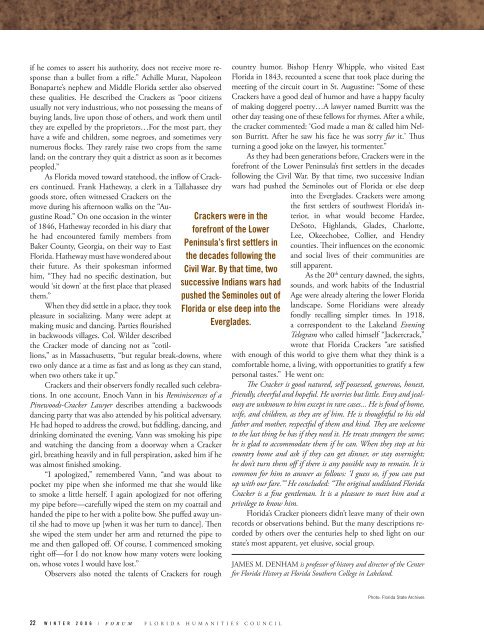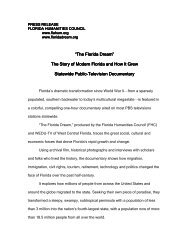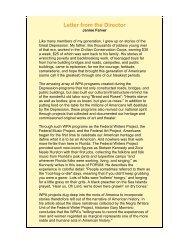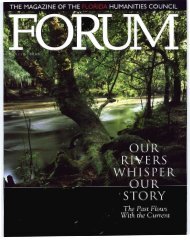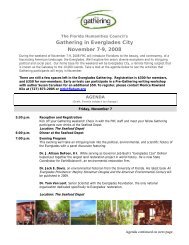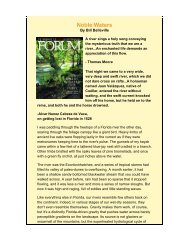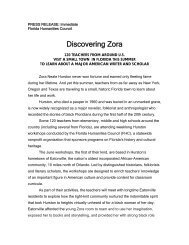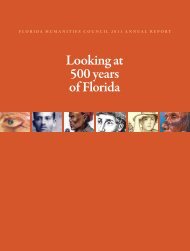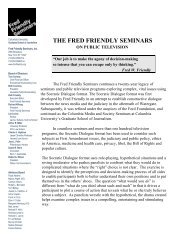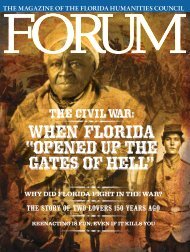THE MAGAZINE OF THE FLORIDA HUMANITIES COUNCIL
THE MAGAZINE OF THE FLORIDA HUMANITIES COUNCIL
THE MAGAZINE OF THE FLORIDA HUMANITIES COUNCIL
You also want an ePaper? Increase the reach of your titles
YUMPU automatically turns print PDFs into web optimized ePapers that Google loves.
if he comes to assert his authority, does not receive more response<br />
than a bullet from a rifle.” Achille Murat, Napoleon<br />
Bonaparte’s nephew and Middle Florida settler also observed<br />
these qualities. He described the Crackers as “poor citizens<br />
usually not very industrious, who not possessing the means of<br />
buying lands, live upon those of others, and work them until<br />
they are expelled by the proprietors…For the most part, they<br />
have a wife and children, some negroes, and sometimes very<br />
numerous flocks. They rarely raise two crops from the same<br />
land; on the contrary they quit a district as soon as it becomes<br />
peopled.”<br />
As Florida moved toward statehood, the inflow of Crackers<br />
continued. Frank Hatheway, a clerk in a Tallahassee dry<br />
goods store, often witnessed Crackers on the<br />
move during his afternoon walks on the “Augustine<br />
Road.” On one occasion in the winter<br />
of 1846, Hatheway recorded in his diary that<br />
he had encountered family members from<br />
Baker County, Georgia, on their way to East<br />
Florida. Hatheway must have wondered about<br />
their future. As their spokesman informed<br />
him, “They had no specific destination, but<br />
would ‘sit down’ at the first place that pleased<br />
them.”<br />
When they did settle in a place, they took<br />
pleasure in socializing. Many were adept at<br />
making music and dancing. Parties flourished<br />
in backwoods villages. Col. Wilder described<br />
the Cracker mode of dancing not as “cotillions,”<br />
as in Massachusetts, “but regular break-downs, where<br />
two only dance at a time as fast and as long as they can stand,<br />
when two others take it up.”<br />
Crackers and their observers fondly recalled such celebrations.<br />
In one account, Enoch Vann in his Reminiscences of a<br />
Pinewoods-Cracker Lawyer describes attending a backwoods<br />
dancing party that was also attended by his political adversary.<br />
He had hoped to address the crowd, but fiddling, dancing, and<br />
drinking dominated the evening. Vann was smoking his pipe<br />
and watching the dancing from a doorway when a Cracker<br />
girl, breathing heavily and in full perspiration, asked him if he<br />
was almost finished smoking.<br />
“I apologized,” remembered Vann, “and was about to<br />
pocket my pipe when she informed me that she would like<br />
to smoke a little herself. I again apologized for not offering<br />
my pipe before—carefully wiped the stem on my coattail and<br />
handed the pipe to her with a polite bow. She puffed away until<br />
she had to move up [when it was her turn to dance]. Then<br />
she wiped the stem under her arm and returned the pipe to<br />
me and then galloped off. Of course, I commenced smoking<br />
right off—for I do not know how many voters were looking<br />
on, whose votes I would have lost.”<br />
Observers also noted the talents of Crackers for rough<br />
country humor. Bishop Henry Whipple, who visited East<br />
Florida in 1843, recounted a scene that took place during the<br />
meeting of the circuit court in St. Augustine: “Some of these<br />
Crackers have a good deal of humor and have a happy faculty<br />
of making doggerel poetry…A lawyer named Burritt was the<br />
other day teasing one of these fellows for rhymes. After a while,<br />
the cracker commented: ‘God made a man & called him Nelson<br />
Burritt. After he saw his face he was sorry fur it.’ Thus<br />
turning a good joke on the lawyer, his tormenter.”<br />
As they had been generations before, Crackers were in the<br />
forefront of the Lower Peninsula’s first settlers in the decades<br />
following the Civil War. By that time, two successive Indian<br />
wars had pushed the Seminoles out of Florida or else deep<br />
into the Everglades. Crackers were among<br />
the first settlers of southwest Florida’s interior,<br />
in what would become Hardee,<br />
DeSoto, Highlands, Glades, Charlotte,<br />
Lee, Okeechobee, Collier, and Hendry<br />
counties. Their influences on the economic<br />
and social lives of their communities are<br />
still apparent.<br />
As the 20 th century dawned, the sights,<br />
sounds, and work habits of the Industrial<br />
Age were already altering the lower Florida<br />
landscape. Some Floridians were already<br />
fondly recalling simpler times. In 1918,<br />
a correspondent to the Lakeland Evening<br />
Telegram who called himself “Jackercrack,”<br />
wrote that Florida Crackers “are satisfied<br />
with enough of this world to give them what they think is a<br />
comfortable home, a living, with opportunities to gratify a few<br />
personal tastes.” He went on:<br />
The Cracker is good natured, self possessed, generous, honest,<br />
friendly, cheerful and hopeful. He worries but little. Envy and jealousy<br />
are unknown to him except in rare cases... He is fond of home,<br />
wife, and children, as they are of him. He is thoughtful to his old<br />
father and mother, respectful of them and kind. They are welcome<br />
to the last thing he has if they need it. He treats strangers the same;<br />
he is glad to accommodate them if he can. When they stop at his<br />
country home and ask if they can get dinner, or stay overnight;<br />
he don’t turn them off if there is any possible way to remain. It is<br />
common for him to answer as follows: ‘I guess so, if you can put<br />
up with our fare.’” He concluded: “The original undiluted Florida<br />
Cracker is a fine gentleman. It is a pleasure to meet him and a<br />
privilege to know him.<br />
Florida’s Cracker pioneers didn’t leave many of their own<br />
records or observations behind. But the many descriptions recorded<br />
by others over the centuries help to shed light on our<br />
state’s most apparent, yet elusive, social group.<br />
Crackers were in the<br />
forefront of the Lower<br />
Peninsula’s first settlers in<br />
the decades following the<br />
Civil War. By that time, two<br />
successive Indians wars had<br />
pushed the Seminoles out of<br />
Florida or else deep into the<br />
Everglades.<br />
22 W I N T E R 2 0 0 6 / F O R U M F L O R I D A H U M A N I T I E S C O U N C I L<br />
JAMES M. DENHAM is professor of history and director of the Center<br />
for Florida History at Florida Southern College in Lakeland.<br />
Photo: Florida State Archives


